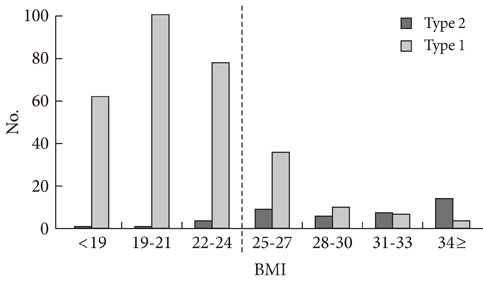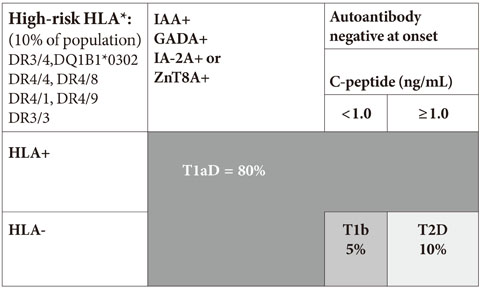Diabetes Metab J.
2012 Apr;36(2):90-97. 10.4093/dmj.2012.36.2.90.
Challenges in Diagnosing Type 1 Diabetes in Different Populations
- Affiliations
-
- 1Barbara Davis Center for Childhood Diabetes, University of Colorado Denver, Aurora, CO, USA. marian.rewers@ucdenver.edu
- KMID: 2281410
- DOI: http://doi.org/10.4093/dmj.2012.36.2.90
Abstract
- Diabetes affects today an estimated 366 million people world-wide, including 20 million to 40 million of patients with type 1 diabetes (T1D). While T1D accounts for 5% to 20% of those with diabetes, it is associated with higher morbidity, mortality and health care cost than the more prevalent type 2 diabetes. Patients with T1D require exogenous insulin for survival and should be identified as soon as possible after diagnosis to avoid high morbidity due to a delay in insulin treatment. It is also important to present to the patient correct prognosis that differs by the type of diabetes. From the research point of view, correct classification should help to identify the etiologies and to develop specific prevention for T1D. This review summarizes evidence that may be helpful in diagnosing T1D in various ethnic groups. Challenges in interpretation of results commonly used to determine the type of diabetes are highlighted.
Keyword
MeSH Terms
Figure
Reference
-
1. American Diabetes Association. Diagnosis and classification of diabetes mellitus. Diabetes Care. 2010. 33:Suppl 1. S62–S69.2. Writing Group for the SEARCH for Diabetes in Youth Study Group. Dabelea D, Bell RA, D'Agostino RB Jr, Imperatore G, Johansen JM, Linder B, Liu LL, Loots B, Marcovina S, Mayer-Davis EJ, Pettitt DJ, Waitzfelder B. Incidence of diabetes in youth in the United States. JAMA. 2007. 297:2716–2724.3. Diabetes Epidemiology Research International Group. Secular trends in incidence of childhood IDDM in 10 countries. Diabetes. 1990. 39:858–864.4. DIAMOND Project Group. Incidence and trends of childhood type 1 diabetes worldwide 1990-1999. Diabet Med. 2006. 23:857–866.5. Harjutsalo V, Sjoberg L, Tuomilehto J. Time trends in the incidence of type 1 diabetes in Finnish children: a cohort study. Lancet. 2008. 371:1777–1782.6. Vehik K, Hamman RF, Lezotte D, Norris JM, Klingensmith G, Bloch C, Rewers M, Dabelea D. Increasing incidence of type 1 diabetes in 0- to 17-year-old Colorado youth. Diabetes Care. 2007. 30:503–509.7. Barker JM, Barriga KJ, Yu L, Miao D, Erlich HA, Norris JM, Eisenbarth GS, Rewers M. Diabetes Autoimmunity Study in the Young. Prediction of autoantibody positivity and progression to type 1 diabetes: Diabetes Autoimmunity Study in the Young (DAISY). J Clin Endocrinol Metab. 2004. 89:3896–3902.8. Rubio-Cabezas O, Minton JA, Caswell R, Shield JP, Deiss D, Sumnik Z, Cayssials A, Herr M, Loew A, Lewis V, Ellard S, Hattersley AT. Clinical heterogeneity in patients with FOXP3 mutations presenting with permanent neonatal diabetes. Diabetes Care. 2009. 32:111–116.9. Imagawa A, Hanafusa T, Miyagawa J, Matsuzawa Y. Osaka IDDM Study Group. A novel subtype of type 1 diabetes mellitus characterized by a rapid onset and an absence of diabetes-related antibodies. N Engl J Med. 2000. 342:301–307.10. Jung TS, Chung SI, Kim MA, Kim SJ, Park MH, Kim DR, Kang MY, Hahm JR. A Korean patient with fulminant autoantibody-negative type 1 diabetes. Diabetes Care. 2004. 27:3023–3024.11. Cho YM, Kim JT, Ko KS, Koo BK, Yang SW, Park MH, Lee HK, Park KS. Fulminant type 1 diabetes in Korea: high prevalence among patients with adult-onset type 1 diabetes. Diabetologia. 2007. 50:2276–2279.12. Kim NH, Kim HY, Seo JA, Choi KM, Baik SH, Choi DS, Kim SG. A pooled analysis of 29 patients with fulminant type 1 diabetes in Korea: a comparison with a nationwide survey in Japan. Diabetes Res Clin Pract. 2009. 86:e43–e45.13. Kim MS, Kim CJ, Ko CW, Hwang PH, Lee DY. Fulminant type 1 diabetes mellitus in Korean adolescents. J Pediatr Endocrinol Metab. 2011. 24:679–681.14. Zheng C, Zhou Z, Yang L, Lin J, Huang G, Li X, Zhou W, Wang X, Liu Z. Fulminant type 1 diabetes mellitus exhibits distinct clinical and autoimmunity features from classical type 1 diabetes mellitus in Chinese. Diabetes Metab Res Rev. 2011. 27:70–78.15. Moreau C, Drui D, Arnault-Ouary G, Charbonnel B, Chaillous L, Cariou B. Fulminant type 1 diabetes in Caucasians: a report of three cases. Diabetes Metab. 2008. 34:529–532.16. McCauley RA, Wang X. Fulminant type 1 diabetes mellitus-like presentation in a Hispanic woman in the United States. Diabetes Metab. 2011. 37:356–358.17. Jung JH, Hahm JR, Kim MA, Park MH, Kim DR, Jung TS, Chung SI. Fulminant autoantibody-negative and type 1A diabetes phenotypes in a Korean HLA identical dizygotic twin. Diabetes Care. 2005. 28:2330–2331.18. Sobngwi E, Vexiau P, Levy V, Lepage V, Mauvais-Jarvis F, Leblanc H, Mbanya JC, Gautier JF. Metabolic and immunogenetic prediction of long-term insulin remission in African patients with atypical diabetes. Diabet Med. 2002. 19:832–835.19. Levitt NS. Diabetes in Africa: epidemiology, management and healthcare challenges. Heart. 2008. 94:1376–1382.20. Gill GV, Mbanya JC, Ramaiya KL, Tesfaye S. A sub-Saharan African perspective of diabetes. Diabetologia. 2009. 52:8–16.21. Hall V, Thomsen RW, Henriksen O, Lohse N. Diabetes in Sub Saharan Africa 1999-2011: epidemiology and public health implications. A systematic review. BMC Public Health. 2011. 11:564.22. Winter WE, Maclaren NK, Riley WJ, Clarke DW, Kappy MS, Spillar RP. Maturity-onset diabetes of youth in black Americans. N Engl J Med. 1987. 316:285–291.23. Banerji MA, Chaiken RL, Huey H, Tuomi T, Norin AJ, Mackay IR, Rowley MJ, Zimmet PZ, Lebovitz HE. GAD antibody negative NIDDM in adult black subjects with diabetic ketoacidosis and increased frequency of human leukocyte antigen DR3 and DR4. Flatbush diabetes. Diabetes. 1994. 43:741–745.24. Maldonado MR, Otiniano ME, Lee R, Rodriguez L, Balasubramanyam A. Characteristics of ketosis-prone diabetes in a multiethnic indigent community. Ethn Dis. 2004. 14:243–249.25. Nalini R, Gaur LK, Maldonado M, Hampe CS, Rodriguez L, Garza G, Lernmark A, Balasubramanyam A. HLA class II alleles specify phenotypes of ketosis-prone diabetes. Diabetes Care. 2008. 31:1195–1200.26. Atkinson MA, Gianani R. The pancreas in human type 1 diabetes: providing new answers to age-old questions. Curr Opin Endocrinol Diabetes Obes. 2009. 16:279–285.27. Wenzlau JM, Juhl K, Yu L, Moua O, Sarkar SA, Gottlieb P, Rewers M, Eisenbarth GS, Jensen J, Davidson HW, Hutton JC. The cation efflux transporter ZnT8 (Slc30A8) is a major autoantigen in human type 1 diabetes. Proc Natl Acad Sci U S A. 2007. 104:17040–17045.28. Bonifacio E, Yu L, Williams AK, Eisenbarth GS, Bingley PJ, Marcovina SM, Adler K, Ziegler AG, Mueller PW, Schatz DA, Krischer JP, Steffes MW, Akolkar B. Harmonization of glutamic acid decarboxylase and islet antigen-2 autoantibody assays for national institute of diabetes and digestive and kidney diseases consortia. J Clin Endocrinol Metab. 2010. 95:3360–3367.29. Yu L, Miao D, Scrimgeour L, Johnson K, Rewers M, Eisenbarth GS. Distinguishing persistent insulin autoantibodies with differential risk: nonradioactive bivalent proinsulin/insulin autoantibody assay. Diabetes. 2012. 61:179–186.30. Dabelea D, Pihoker C, Talton JW, D'Agostino RB Jr, Fujimoto W, Klingensmith GJ, Lawrence JM, Linder B, Marcovina SM, Mayer-Davis EJ, Imperatore G, Dolan LM. SEARCH for Diabetes in Youth Study. Etiological approach to characterization of diabetes type: the SEARCH for Diabetes in Youth Study. Diabetes Care. 2011. 34:1628–1633.31. Savola K, Sabbah E, Kulmala P, Vahasalo P, Ilonen J, Knip M. Autoantibodies associated with type I diabetes mellitus persist after diagnosis in children. Diabetologia. 1998. 41:1293–1297.32. Doria A, Yang Y, Malecki M, Scotti S, Dreyfus J, O'Keeffe C, Orban T, Warram JH, Krolewski AS. Phenotypic characteristics of early-onset autosomal-dominant type 2 diabetes unlinked to known maturity-onset diabetes of the young (MODY) genes. Diabetes Care. 1999. 22:253–261.33. Gach A, Wyka K, Malecki MT, Noczynska A, Skupien J, Nazim J, Szalecki M, Bodalski J, Sieradzki J, Mlynarski W. Islet-specific antibody seroconversion in patients with long duration of permanent neonatal diabetes caused by mutations in the KCNJ11 gene. Diabetes Care. 2007. 30:2080–2082.34. Palmer JP, Fleming GA, Greenbaum CJ, Herold KC, Jansa LD, Kolb H, Lachin JM, Polonsky KS, Pozzilli P, Skyler JS, Steffes MW. C-peptide is the appropriate outcome measure for type 1 diabetes clinical trials to preserve beta-cell function: report of an ADA workshop, 21-22 October 2001. Diabetes. 2004. 53:250–264.35. Third National Health and Nutrition Examination Survey (NHANES III). Centers for Disease Control and Prevention. updated 2011 Oct 28. Available from: http://www.cdc.gov/nchs/nhanes/nh3data.htm.36. Greenbaum CJ, Anderson AM, Dolan LM, Mayer-Davis EJ, Dabelea D, Imperatore G, Marcovina S, Pihoker C. SEARCH Study Group. Preservation of beta-cell function in autoantibody-positive youth with diabetes. Diabetes Care. 2009. 32:1839–1844.37. Rewers M, Bugawan TL, Norris JM, Blair A, Beaty B, Hoffman M, McDuffie RS Jr, Hamman RF, Klingensmith G, Eisenbarth GS, Erlich HA. Newborn screening for HLA markers associated with IDDM: diabetes autoimmunity study in the young (DAISY). Diabetologia. 1996. 39:807–812.38. Hagopian WA, Erlich H, Lernmark A, Rewers M, Ziegler AG, Simell O, Akolkar B, Vogt R Jr, Blair A, Ilonen J, Krischer J, She J. TEDDY Study Group. The Environmental Determinants of Diabetes in the Young (TEDDY): genetic criteria and international diabetes risk screening of 421 000 infants. Pediatr Diabetes. 2011. 12:733–743.39. Harjutsalo V, Podar T, Tuomilehto J. Cumulative incidence of type 1 diabetes in 10,168 siblings of Finnish young-onset type 1 diabetic patients. Diabetes. 2005. 54:563–569.40. Steck AK, Barriga KJ, Emery LM, Fiallo-Scharer RV, Gottlieb PA, Rewers MJ. Secondary attack rate of type 1 diabetes in Colorado families. Diabetes Care. 2005. 28:296–300.41. Rewers M. The fallacy of reduction. Pediatr Diabetes. Epub 2011 Nov 8. DOI: 10.1111/j.1399-5448.2011.00832.x.42. Schauer IE, Snell-Bergeon JK, Bergman BC, Maahs DM, Kretowski A, Eckel RH, Rewers M. Insulin resistance, defective insulin-mediated fatty acid suppression, and coronary artery calcification in subjects with and without type 1 diabetes: the CACTI study. Diabetes. 2011. 60:306–314.
- Full Text Links
- Actions
-
Cited
- CITED
-
- Close
- Share
- Similar articles
-
- Diabetes Self-Management in Vulnerable Populations
- Comparison of the Efficacy of Dipeptidylpeptidase-4 Inhibitors Between Asian and Non-Asian Populations
- Polygenic Risk Score and Precision Medicine in Diabetes
- The Importance of Global Studies of the Genetics of Type 2 Diabetes
- Sodium-Glucose Cotransporter 2 Inhibitors for People with Type 1 Diabetes




